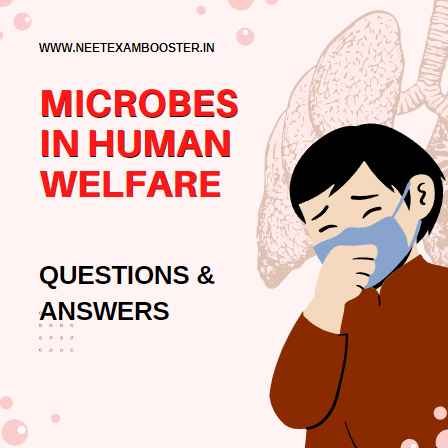Microbes In Human Welfare Class 12:- The microbes are a very important part of life on earth.All microbes are nonpathogenic. Microbes are very useful to human beings.Microbes are used to produce industrial products such as lactic acid,acetic acid and alcohol,they are used in different process in the industry.

Microbes In Human Welfare Class 12 – Very Short Answer Type Questions
Q.1. What are the reason of there big holes in ‘Swiss cheese’?
A.1. This is due to the bacterium named Propionibacterium shermanii which releases large amounts of carbon dioxide.
Q.2. Define fermentor.
A.2. To cater the large scale production of the biotechnological products such as the beverages and the antibiotics in industries, microbes are grown in the large vessels called as bioreactors or fermentors.
Q.3. Give an example of a microbe which is used in the statin production. How can we say that they lower blood cholesterol level?
A.3. The statins are produced by the yeasts named as Monascuspurpureus and they are bioactive molecules. These stains have been commercialized as the agents that aid in lowering the blood cholesterol levels. This is competitively inhibits the action of the enzymes which synthesize cholesterol.
Microbes In Human Welfare Class 12
Q.4. Why is the secondary wastewater treatment plant referred to as the biological approach?
A.4. This is due to microbes are involved in the breakdown of the organic matter in this stage of wastewater management. The Primary effluents are passed into the aeration tanks where the organic matter contained in it is absorbed by the aerobic microbes which are later digested by the anaerobic fungi and the bacteria in sludge digesters.
Q.5. What are the uses of Nuclear Polyhedrosis Virus.
A.5. They are excellent candidates for the narrow-spectrum, the species-specific insecticidal applications that have shown to have no negative impact on mammals, the plants, birds, fish or even the non-target insects which is desirable when the beneficial insects are being conserved to promote the Integrated Pest Management(IPM) programme.
Q.6. What are the significance of the antibiotics in medicinenal field ?
A.6. They are the chemical substances, that produced by a few microbes which have the potential to kill or retard the growth of the disease-causing microbes. They have greatly enhanced the human capacity to treat the deadly diseases such as plague, diphtheria, leprosy, whooping cough etc.
Q.7. We distil to produce the few alcoholic drinks why so?
A.7. This is due to the distillation raises the alcohol content in the few alcoholic drinks.
Microbes In Human Welfare Class 12 Quiz
Q.8. Which are the common trait shared between the Clostridium butylicum, Lactobacillus and the Aspergillus niger.
A.8. As part of their metabolic activities, they produce the organic acids that can be used for their industrial and the commercial production. The Clostridium butylicum – butyric acid,the Lactobacillus-lactic acid and the Aspergillus niger – citric acid.
Q.9. What happens if the human intestine nourished the microbial flora correctly equivalent to the one found in the rumen of the cattle?
A.9. We would be able to the digest cellulose in our food as the microbes(methanogens) present in the cattle’s rumen can digest the cellulose since they contain the enzyme cellulase.
Q.10. Write the name of the two microbes beneficial in biotechnology.
A.10. The Escherichia coli and the Bacillus thuringiensis
Q.11. Write the name of the organism responsible for the Eco RI, restriction endonuclease?
A.11. The Escherichia coli strain RY 13
Q.12. Make a list of any crop which is genetically modified.
A.12. Bt cotton developed by the inserting a gene from the Bacillus thuringiensis is genetically modified to resist the attack from the insect pests.
Q.13. Whats the reason for the blue-green algae not as popular as the biofertilizers?
A.13. This is because of the several environmental constraints such as the infrastructural, technological, financial, quality marketing, unawareness etc.
Q.14. Roquefort cheese is obtained from……?
A.14. Roquefort chesse is obtained from the Fungi Penicillium roqueforti
Q.15. Write the name of the states which are involved in the Ganga action plan?
A.15. Jharkhand, UP, Bihar, West Bengal are involved in the Ganga action plan.
Q.16. Make a list of the two industrially significant enzymes.
A.16.
(i) The Proteases and the pectinases are used in making the commercial fruit and the vegetable juices are clarifying agents
(ii)They are helpful in removing oily stains from the laundry as the upases are used in the detergent formulations.
Q.17. Make a list of an immune immunosupressive agent.
A.17. Fungus Trichodermapolysporum produces the Cyclosporin-A that is used as an immunosuppressive agent in the organ transplant patients.
Q.18. Write the name of a rod-shaped virus.
A.18. Tobacco mosaic virus is the rod shaped virus.
Microbes In Human Welfare Class 12 Books for neet
Q.19. Write the name of the class of bacteria found both in the sludge of sewage treatment and in the rumen of the cattle.
A.19. Methanogens(Methanobacterium) are present in both in the slude of sewage treatment and in the rumen of the cattle.
Microbes In Human Welfare Class 12 – Short Answer Type Questions
Q.1. What are the importance of the floes in the biological treatment of wastewater?
A.1. They are the portions of the bacteria related to fungal filaments that form the mesh-like structures. It helps in the digestion of the organic matter, eliminate the pathogens and liberate the nutrients in the sewage effluents.
Q.2. Write the role of the bacteria Bacillus thuringiensis in regulating the caterpillars of insect pests?
A.2. It produces an endotoxin that upon the ingestion and the liberation into the gut of the larvae of the insect pest, destructs the gut lining of the insect therefore killing it.
Q.3. How can we say that he fungi mycorrhizal benefit the plant in which it harbours ?
A.3. It absorbs the phosphorous from the soil and it transfers to the host cells. They also provide the resistance against the root pathogens to the host plants. It promotes the overall development and the growth of the plant and it shows the tolerance to the drought and the salinity. Thus the fungal hyphae aids in producing the organic food and also procure the nourishment and the shelter from higher plants.
Q.4. How are the cyanobacteria useful in the fields of paddy?
A.4. Cyanobacteris fix nitrogen from the atmosphere and the supplement organic matter to increase the fertility of the soil. For Examples – Nostoc, Anabaena, Oscillatoria.
Q.5. Write about discovery of the Penicillin.
A.5. Pencillin was the first antibiotic to be discovered and it is an accidental discovery by the scientist. Alexander Fleming noted a mould of Penicillium growing in the unlaundered culture plates of the Staphylococcus. The mould hindered the growth of the Staphylococcus. Abhintibiotic was later isolated from the fungus to be named as after the mould Penicillium notatum.
Q.6. Who was credited for the demonstrating the importance of the Penicillin as an antibiotic?
A.6. Howard Florey and Ernst Chain was credited for the demonstration of the importance of Pencillin as an antibiotic.
Q.7. How can we say that the restoration of the good health in humans brought about by the bioactive molecules of fungal origin?
A.7. The Cyclosporin-A is utilized as an immunosuppressant in the organ transplant patients that is generated by the fungus Trichodermapolysporum. The yeast Monococcuspurpureus produce the Statins that are commercially used as agents which lower blood cholesterol levels.
Microbes In Human Welfare Class 12
Q.8. Write the importance of the enzymes in the detergents used for washing clothes. Are they produced from unique microbes?
A.8. The Lipases are used in the formulations of the detergent that result in the breakdown of oil hence aids in the removal of grease and the stains of oil from the clothes. They are obtained from the Geotrichumcandidum and the Candida lipolytica.
Q.9. Write about the chemical nature of the biogas. Write the name of one organism which produces the biogas.
A.9.
- The Chemical nature of the biogas – CH4 , CO2 , H2.
- A variety of the methanogen – Methanobacteria is involved in the biogas production.
Q.10. What atr the role of the microbes in reducing the environmental degeneration caused by the chemicals?
A.10. The Microbes are being used as the pesticides and the fertilizers to reduce the environmental degradation and are known as the biopesticides and the biofertilizers respectively. As biofertilizers, the microbes enrich soil nutrients by fixing the atmospheric nitrogen in the soil, For examples – Azospirillum, Azotobacter, Rhizobium etc. As the biopesticides(Bacillus thuringiensis) they check the growth of the insect pests. A fungal species – Trichoderma is effectively used as the biocontrol agent for the many plant pathogens. The Baculovirus in the genus nucleopolyhedrovirus is used as a biological control agent for the narrow spectrum, species-specific insecticidal applications.
Q.11. Explain broad-spectrum antibiotic. Write an example.
A.11. Broad spectrum antibiotic hinders the maturity of the both gram-negative and the gram-positive bacteria. For Example – Jetracyclines, Phenicols, Fluoroquinolones.
Q.12. Give the another name used to address the viruses parasitizing the bacteria?
A.12. The Bacteriophages. These are the viruses that do not eat the bacteria. They can infect and replicate within the bacteria.
Q.13. Write the name of the bacteria that is used as the clot buster.Write about its mode of the action.
A.13. Bacterium Streptococcus secretes the Streptokinase that is used as the clot buster. It has a fibrinolytic action that breaks down the clots which are formed in the blood vessels of the patients which undergo the myocardial infarction that prevents heart attack in such patients which can otherwise occur due to occlusion by clots.
Microbes In Human Welfare Class 12
Q.14. Describe the biofertillizers by giving two examples.
A.14. The Biofertilizers supplement tnutrient quality of the soil. Their main source is fungi, bacteria and the cyan bacteria. The Fizotobacter, the Rhizobium can fix the atmospheric nitrogen in the soil. The Blue-green algae like Nostoc, Anabaena add organic matter to the soil and increase the soil fertility.
Microbes In Human Welfare Class 12 – Long Answer Type Questions
Q.1. For the execution of the massive volumes of the waste waters rich in the organic matter, why is the aerobic degradation is more important than this anaerobic degradation?
A.1. This is due to facultative and the aerobic microbes which occur naturally such as the protozoa, fungi, bacteria etc residing in the wastewater can rapidly oxidize soluble the organic and the nitrogenous compounds. The process if further accelerated because of the mechanical addition of oxygen therefore eliminating the most of the pathogenic content of the effluent.
Q.2. Describe the main ideologies crucial in the biological control of the diseases and the pests.
A.2. The fundamental idea is this is the natural and the eco-friendly. It involves the utilization of the living body to monitor the community of the pests and the pathogens in an ecosystem. For example Trichoderma, it is an antagonist that acts against the certain soil-borne plant pathogens. Likewise,the Penicillin hinders the growth of the Staphylococcus and therefore has been used in the penicillin production to check the several bacterial pathogens. Baculovirus in the genus Nucleopolyhedrovirus is used as the biological control agent for the species-specific the narrow-spectrum insecticidal application. The Bacillus thuringiensis is used to control the insects as it acts as a biopesticide. The complete biological regulation of the pest is observed to be much more advantageous in an ecologically sensitive area.
Q.3.
a) What is consequence of discharging the larger volumes of the sewage which is untreated into a river?
b) What are the significance of the anaerobic sludge digestion in the sewage treatment?
A.3. a) If water is untreated and they dispensed directly into the rivers it will lead to adverse water pollution with the pathogenic bacteria, protozoa and the organic matter. If this water is consumed, it would lead to the outbreaks of the water-borne diseases.
b) The Anaerobic bacteria digest the aerobic bacteria and the fungi which are present in the sludge and the residual organic matter in the anaerobic sludge digestion. During this digestion, a mixture of the gases is produced such as hydrogen sulphide, methane and the carbon dioxide. These biogases can be utilized as the source of the energy as it is inflammable.
Q.4. Explain the kind of the food which would have lactic acid bacteria. Write their useful applications.
A.4. Lactic Acid Bacteria(LAB) of the Lactobacillus species is the most commonly found in the food items such as curd and yoghurt. During the formation of the curd, a small amount of the curd is added to milk that acts as an initiator. The Microbes present in the starter rapidly multiply at the suitable temperatures, thereby causing the conversion of the milk into the curd. The Lactic acid bacteria releases the acids during the growth curdle and they digest the milk protein partially that thereby facilitates the digestibility of the milk protein. Few of its applications are given below:
- It Enhances the nutritional quality of the milk by increasing the vitamin B-12 content
- It Regulates the disease-checking microbes in the stomach
Microbes In Human Welfare Class 12
Q.5. How can we say that the microbes be used to decrease the use of the chemical fertilizers and the pesticides?
A.5. The chemical fertilizers and the pesticides are an effective way to protect the plants against the diseases and to enhance their growth. But these fertilizer and the pesticides contain a large amount of toxic chemicals. These chemicals are very harmful for the plants if provided in the large quantities. They can also adversely affect the human health and the environment. Therefore the microbes are devised as an alternative.
The Microbes such as Bacillus thuringiensis and Rhizobium were used to control the pests and to the retain soil fertility to enhance plant growth. They are environment friendly and they have no toxic effects on the human and the plant health.
Click here to join our telegram channel for more important questions and answers like Microbes In Human Welfare Class 12.



















